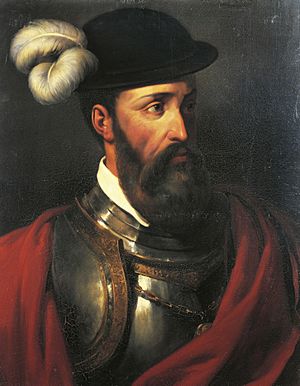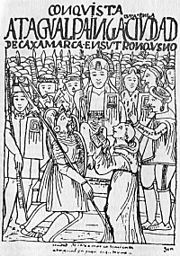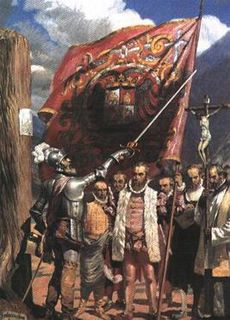Spanish conquest of the Inca Empire facts for kids
Quick facts for kids Spanish conquest of the Inca Empire |
|||||||||
|---|---|---|---|---|---|---|---|---|---|
| Part of the Spanish conquest of the Americas | |||||||||
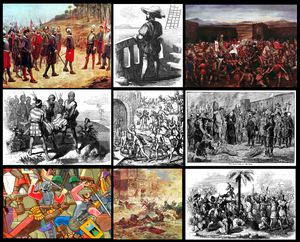 Spanish conquest of Peru |
|||||||||
|
|||||||||
| Belligerents | |||||||||
|
|
|||||||||
| Commanders and leaders | |||||||||
|
1st phase (1532–35):
|
||||||||
| Strength | |||||||||
| 168 soldiers (1532) Unknown number of native auxiliaries +3,000 Spanish soldiers and tens of thousands of indigenous allies (1535) |
100,000 soldiers (1532) Tens of thousands of warriors (1535) |
||||||||
| Casualties and losses | |||||||||
| Unknown | Unknown | ||||||||
The Spanish conquest of the Inca Empire, also known as the Conquest of Peru, was a very important event in the Spanish colonization of the Americas.
When the Spanish arrived in 1528, the Inca Empire was the largest of the great civilizations in the Americas before Christopher Columbus. Emperor Huayna Capac ruled this huge empire. He was a descendant of Manco Cápac, the legendary founder of the Inca people.
Huayna Capac had many children, but two of his sons became very important. Huáscar was the son of a royal queen. Atahualpa was likely the son of a princess from the Kingdom of Quitu. These two sons played key roles in the final years of the Inca Empire.
The Spanish conquistador Francisco Pizarro and his men had a big advantage. They invaded when the Inca Empire was in the middle of a civil war between Huáscar and Atahualpa. Atahualpa had spent more time with his father, Huayna Capac, while the army was conquering Ecuador. This meant Atahualpa had better connections with the army and its generals.
In 1528, both Huayna Capac and his chosen heir, Ninan Cuyochi, died suddenly. They likely died from smallpox, a disease brought by the Spanish to the Americas. This left the question of who would be the next emperor unanswered. Huáscar was in the capital city of Cuzco, while Atahualpa was in Quito with the main Inca army. Huáscar declared himself Sapa Inca (meaning "Only Emperor") in Cuzco. But the army stayed loyal to Atahualpa. This disagreement led to the Inca Civil War.
Contents
Key Events of the Inca Empire's Last Years
- Around 1528 – Francisco Pizarro and Diego de Almagro first meet the Inca Empire at Tumbes. The Inca Emperor Huayna Capac dies from smallpox. This starts a civil war between his sons, Atahualpa and Huáscar.
- 1528–1529 – Pizarro goes back to Spain. The Queen of Spain gives him permission to conquer Peru.
- 1531–1532 – Pizarro's third trip to Peru. The Spanish team up with native groups like the Huancas, Chankas, Cañaris, and Chachapoyas. These groups felt oppressed by the Inca Empire. Pizarro adds them to his troops to fight the Incas. Atahualpa is captured by the Spanish.
- 1533 – Almagro arrives. Atahualpa is executed after he orders Huáscar to be killed. Pizarro takes control of Cuzco and makes seventeen-year-old Manco Inca the new Inca Emperor.
- 1535 – Pizarro founds the city of Lima. De Almagro leaves for what is now Chile.
- 1536 – Gonzalo Pizarro takes Manco Inca's wife, Cura Olcollo. Manco rebels and surrounds Cuzco. Juan Pizarro is killed. Inca general Quizo Yupanqui attacks Lima.
- 1537 – Almagro takes Cuzco from Hernando and Gonzalo Pizarro. Rodrigo Orgóñez attacks Vitcos and captures Manco Inca's son, Titu Cusi. Manco escapes to Vilcabamba, which becomes the capital of the Neo-Inca State.
- 1538 – Hernando Pizarro executes Diego de Almagro.
- 1539 – Gonzalo Pizarro invades Vilcabamba. Manco Inca escapes, but Francisco Pizarro executes Manco's wife, Cura Olcollo.
- 1541 – Francisco Pizarro is murdered by Diego de Almagro II and other supporters of De Almagro.
- 1544 – Manco Inca is murdered by supporters of Diego de Almagro. The Inca revolt continues.
- 1572 – The Viceroy of Peru, Francisco Toledo, declares war on the Neo-Inca State. Vilcabamba is attacked. Túpac Amaru, the last Inca Emperor, is captured and executed in Cuzco. The Neo-Inca capital of Vilcabamba is abandoned. The Spanish move its people to a new Christian town.
The Start of the Conflict
The civil war between Atahualpa and Huáscar made the Inca Empire weak just before the Spanish arrived. Atahualpa seemed more popular with the people than his brother. He was also highly valued by the army, which was based in the recently conquered northern province of Quito.
At the beginning of the war, each brother controlled his own areas. Atahualpa was strong in the north. Huáscar controlled the capital, Cuzco, and the large southern territory. This southern region provided many soldiers for Huáscar's army. After some diplomatic talks, open war began. Huáscar seemed ready to win quickly. His troops captured Atahualpa during a festival in the city of Tumebamba.
However, Atahualpa quickly escaped and returned to Quito. There, he gathered about 30,000 well-trained soldiers. Huáscar also gathered about the same number of soldiers, but they were much less experienced.
Atahualpa sent his forces south under his top generals, Challcuchima and Quisquis. They won many battles against Huáscar. Soon, they reached the gates of Cuzco. On the first day of the battle for Cuzco, Huáscar's forces gained an early lead. But on the second day, Huáscar led a "surprise" attack that his generals, Challcuchima and Quisquis, already knew about. In the battle, Huáscar was captured, and his army completely fell apart.
The winning generals sent news to Atahualpa, who had moved south to the royal springs outside Cajamarca. The messenger arrived with news of the victory on the same day that Pizarro and his small group of adventurers, along with some native allies, came down from the Andes mountains into Cajamarca.
Pizarro's Arrival in Peru
Francisco Pizarro and his brothers (Gonzalo, Juan, and Hernando) were drawn by stories of a rich kingdom. In 1529, Francisco Pizarro got permission from the Spanish King to conquer the land they called Peru.
When Pizarro arrived in Peru in 1532, it was very different from his last visit five years before. In the ruins of Tumbes, he tried to understand the situation. Two local boys, whom Pizarro had taught Spanish, told him about the civil war and the disease that was hurting the Inca Empire.
After four long trips, Pizarro set up the first Spanish settlement in northern Peru. He called it San Miguel de Piura.
When the natives first saw Pizarro and his men, they thought they might be Viracocha Cuna, or "gods." The natives described Pizarro's men to the Inca. They said the "capito" (Pizarro) was tall, had a full beard, and was completely covered in clothing. Atahualpa was worried about what these new white men could do. If they were runa quicachac ("destroyers of peoples"), he should run away. If they were Viracocha Cuna Runa allichac ("gods who help people"), he should welcome them.
The messengers went back to Tangarala. Atahualpa sent Cinquinchara, an Orejon warrior, to the Spanish to be an interpreter. After traveling with the Spanish, Cinquinchara returned to Atahualpa. They discussed whether the Spanish men were gods. Cinquinchara decided they were just men because he saw them eat, drink, and dress. He saw them perform no miracles. Cinquinchara told Atahualpa that there were only about 170–180 of them. When Atahualpa asked what to do, Cinquinchara advised that they should be killed.
Atahualpa's Capture
After winning the civil war and capturing his brother Huáscar, Atahualpa was resting at the Inca baths outside Cajamarca. Pizarro and his men reached the city on November 15, 1532.
Pizarro sent Hernando de Soto to Atahualpa's camp. Soto rode his horse to meet Atahualpa. Atahualpa had never seen a horse before. With a young interpreter, Soto read a speech to Atahualpa. He said they had come as servants of God to teach them about God's word. They also invited the Inca leader to visit Pizarro at his quarters in the Cajamarca plaza. When De Soto saw Atahualpa was interested in his horse, he showed off his "excellent horsemanship" very close to Atahualpa. Atahualpa was friendly and offered them refreshments.
Atahualpa only responded after Francisco Pizarro's brother, Hernando Pizarro, arrived. Atahualpa said he had heard from his scouts that the Spanish had been killing and enslaving many people on the coast. Pizarro denied this report. Atahualpa, with limited information, let the matter go. At the end of their meeting, they agreed to meet the next day in Cajamarca.
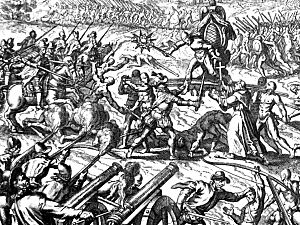
The next morning, November 16, 1532, Pizarro set up an ambush around the Cajamarca plaza where they were to meet. Pizarro had 168 men: 106 on foot and 62 on horseback. Atahualpa arrived with about 6,000 unarmed followers. Friar Vincente de Valverde and the interpreter Felipillo met them. The friar tried to explain Christian beliefs and asked Atahualpa to become a subject of King Charles. The poor translation likely caused problems. The friar offered Atahualpa the Bible as proof of what he said. Atahualpa stated, "I will be no man's tributary."
Pizarro ordered the attack, starting the Battle of Cajamarca. The battle began with a cannon shot and the battle cry "Santiago!" The Spaniards fired their guns at the large group of Incas and charged forward. Pizarro also used powerful cavalry charges against the Inca forces. This, combined with the gunfire, shocked the Incas. Many of the Spanish guns were hard to use in close fighting. The effect was terrible. The Incas offered such weak resistance that the battle is often called a massacre. About 2,000 Incas were killed, and only one Spanish soldier was wounded.
Pizarro knew his forces were greatly outnumbered. But capturing the Emperor and holding him hostage would give him a huge advantage.
After capturing Atahualpa, the Spanish allowed his wives to join him. The Spanish soldiers even taught him how to play chess. During his captivity, the Spanish, though outnumbered, forced Atahualpa to order his generals to stand down. They threatened to kill him if he didn't. Atahualpa offered to fill a large room with gold and twice that amount in silver. Pizarro pretended to accept this offer and allowed the gold to pile up. However, he never intended to release the Inca. He needed Atahualpa's influence over his generals and the people to keep the peace. Treasure began arriving from Cuzco on December 20, 1532, and continued to flow in. By May 3, 1533, Pizarro had received all the treasure he asked for. It was melted down and made into bars.
The question eventually came up of what to do with Atahualpa. Both Pizarro and Soto reportedly spoke against killing him, but other Spaniards disagreed. False interpretations from the interpreter Felipillo made the Spaniards paranoid. They were told that Atahualpa had ordered secret attacks and that his warriors were hidden nearby. Soto went with a small group to search for the hidden army. Atahualpa's trial was held while Soto was away. Among the charges were having many wives and worshipping idols. These were frowned upon in Catholicism but were common in Inca culture and religion.
Those against Atahualpa's conviction argued that he should be judged by King Charles, as he was a king. Atahualpa was forced to be baptized to avoid being burned alive. He hoped to rejoin his army and kill the Spanish one day. They called him Francisco for the baptism. On August 29, 1533, the Spanish killed Atahualpa. He was buried with Christian rites in the church of San Francisco at Cajamarca. But his body was soon dug up. It was taken to its final resting place in Quito, probably as he had wished. When de Soto returned, he was furious. He had found no evidence of any secret Inca army.
Pizarro then moved with his army of 500 Spaniards toward Cuzco, joined by Chalcuchimac. Manco Inca Yupanqui joined Pizarro after the death of Túpac Huallpa. Pizarro's forces entered the heart of the Tawantinsuyu on November 15, 1533.
Inca Rebellion and Spanish Reconquest
After Atahualpa's murder, Pizarro made Atahualpa's brother, Túpac Huallpa, a puppet Inca ruler. But he died unexpectedly, leaving Manco Inca Yupanqui in power. Manco Inca started his rule as an ally of the Spanish. However, in 1535, he was left in Cuzco under the control of Pizarro's brothers, Juan and Gonzalo. They treated Manco Inca so badly that he finally rebelled. Manco escaped Cuzco by pretending he needed to find a pure gold statue in the nearby Yucay valley.
Manco Inca hoped to recapture Cuzco starting in April 1536. The siege of Cuzco lasted until the next spring. During that time, Manco's armies destroyed four Spanish relief groups sent from Lima. But he ultimately failed to drive the Spaniards out of the city. The Inca leaders did not have the full support of all their people. Also, the low morale of the Inca army and the Spanish's better siege weapons soon made Manco Inca realize he couldn't recapture Cuzco. Manco Inca retreated to the mountainous region of Vilcabamba. He established a small Neo-Inca State there. Manco Inca and his successors held some power for several more decades. His son, Túpac Amaru, was the last Inca ruler. He was killed by the Spanish in 1572.
In total, the conquest took about forty years to complete. Many Inca attempts to regain their empire happened, but none succeeded. The Spanish conquest was helped by factors like smallpox. The Spaniards destroyed much of the Inca culture and forced Spanish culture onto the native people.
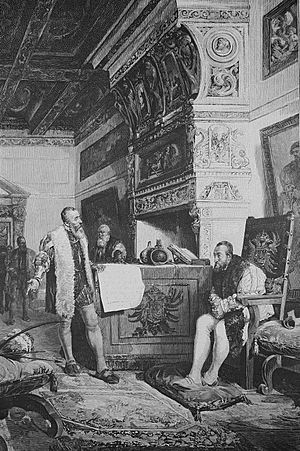
Aftermath of the Conquest
Spanish culture was brought to Peru not only by Pizarro and his captains. Many other Spanish people also came to Peru to get rich and live there. These included Spanish merchants, farmers, craftspeople, and Spanish women. The Spanish also brought African slaves to work alongside captured Incas. They worked in agriculture and silver mining.
Impact on Peru's Population
The Inca population dropped quickly and dramatically. It is estimated that the population of the Inca Empire fell from about 10 to 12 million in 1520 to less than 3 million in 1570. The population continued to decline after 1570.
The biggest reason for this huge drop in native populations was infectious diseases from the Old World. These diseases were carried by colonists and conquistadors. Since the natives had never been exposed to these diseases, they had no immunity and died at very high rates. More people died from disease than from any army or conflict. The Inca did not have a strong writing tradition like the Aztec or Maya. This makes it hard for historians to estimate population decline or other events after the conquest. Some scholars argue that the Inca started getting these diseases several years before the Spanish arrived. The diseases might have been carried to their empire by traders and travelers.
Besides the devastation from disease, the local populations suffered greatly from enslavement, looting, and destruction from warfare. The Spanish policy was that if local people willingly accepted Spanish rule, they would be safe. But if they resisted, it would lead to more deaths and destruction.
Another big impact on the people in South America was the spread of Christianity. As Pizarro and the Spanish took control of the continent, they forced many people to convert to Christianity. Within just one generation, the entire continent was under Christian influence.
Environmental Changes
Recent research shows that the Spanish conquest of the Inca changed Peru's coastline. Before the Spanish arrived, people living on the dry northern Peruvian coast covered huge sand dune-like ridges. They used millions of discarded mollusk shells to create a kind of "armor." This protected the ridges from erosion for almost 4700 years before the Spanish came. It created a vast wavy landscape that can be seen from space.
However, this accidental protection ended quickly. Diseases brought by Spanish colonists killed many local people. Colonial officials then moved the survivors inland. Without humans to create the protective shell covering, newly formed beach ridges simply eroded and disappeared.
In Stories and Media
Many stories, plays, and books have been written about the Spanish conquest of the Inca Empire.
- Jean-François Marmontel's novel Les Incas, ou la destruction de l'empire du Perou (1777) tells a made-up version of the conquest. It shows the author's views on the religious extremism of the Conquistadors and their cruelty.
- Verdi's opera Alzira (1845) is set during the Conquest. An Inca named Zamoro wants to find Princess Alzira, who is engaged to the Conquistador Gusmano.
- The second act of Rameau's Les Indes galantes (1735) is called Les incas du Pérou. It tells a love story between a Spanish Conquistador and an Inca princess.
- The Spanish play La aurora en Copacabana by Pedro Calderón de la Barca shows the Conquest from a religious view. It includes characters that represent Idolatry and the conversion of Native Peruvians to Christianity.
- The first part of Madame de Graffigny's novel Lettres d'une Péruvienne describes the kidnapping of Zilia, an Inca princess, by the Spaniards during the Conquest.
- Peter Shaffer's play The Royal Hunt of the Sun (1964) tells the story of the Inca conquest. Pizarro, Atahualpa, Valverde, and other historical figures appear as characters.
- This event is also told as a science fiction story in Randall Garrett's Despoilers of the Golden Empire (1959).
- The Ransom Room is the setting for the romance novel Das Gold von Caxamalca (1928) by German writer Jakob Wasserman.
- The conquest is also the starting point for the Matthew Reilly novel Temple. The siege of Cusco is used, and many historical figures, especially Pizarro, are mentioned.
- The Inca are featured in the third Campaign in Age of Empires 3. They have a Lost City hidden in the Andes. They are also in the Multiplayer game, found mainly in Chile and Argentina. In the Definitive Edition of the game, they are a playable group.
- The conquest is made fun of in The Simpsons TV series, in the episode "Lost Verizon".
- Pizarro and his fellow conquistadors are bad guys in the 1982 animated series The Mysterious Cities of Gold.
See Also
 In Spanish: Conquista del Imperio incaico para niños
In Spanish: Conquista del Imperio incaico para niños
- Ancient Peru
- Encomiendas in Peru
- Habsburg Spain
- History of Peru
- Inca society
- Indian reductions in the Andes
- Paititi
- Pambokancha, an Inca religious site
- Reductions
- Spanish conquest of the Aztec Empire
- Spanish conquest of the Maya
- Spanish conquest of the Muisca
- Spanish conquest of Yucatán



